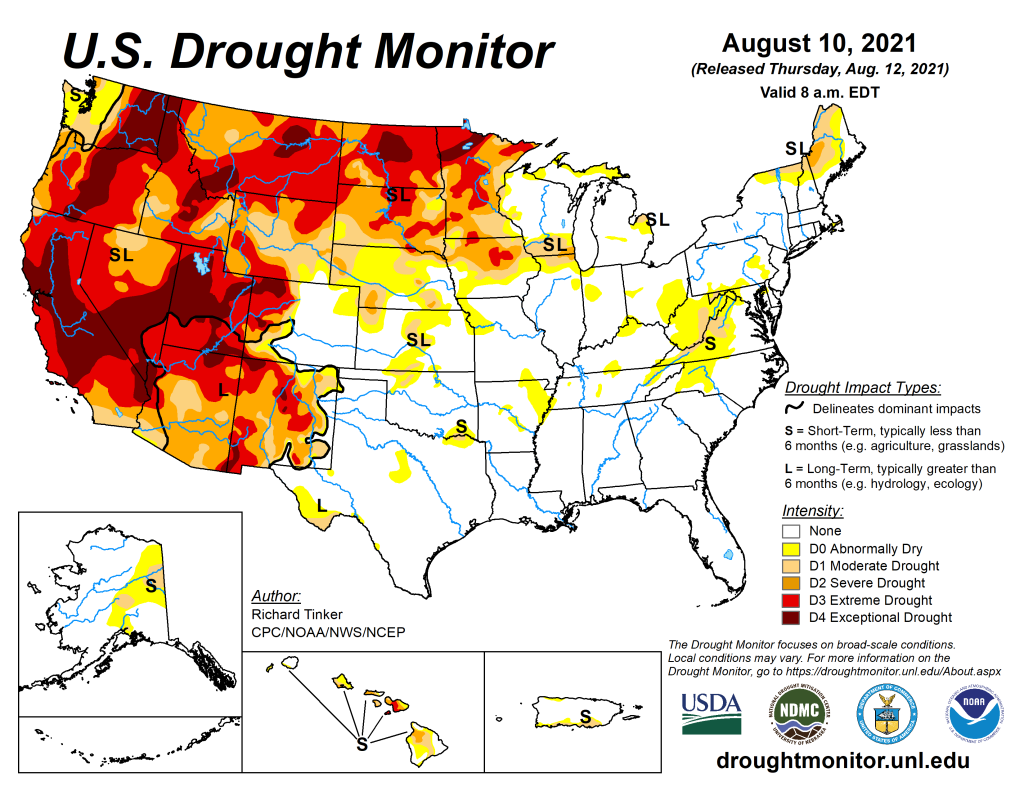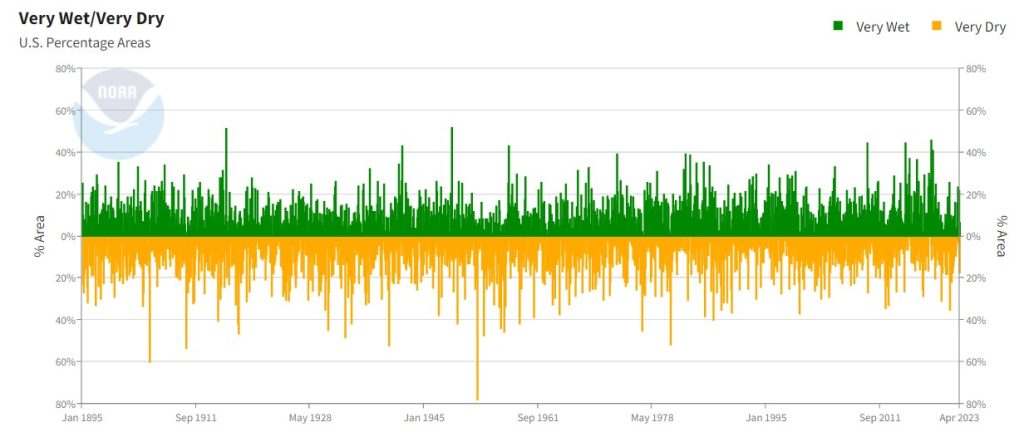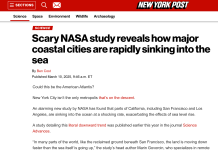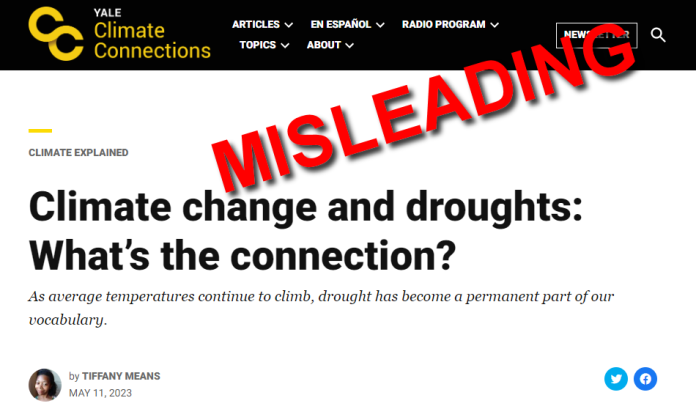A May 11, 2023 opinion piece in Yale Climate Connections (YCC) titled, “Climate change and droughts: What’s the connection?” link climate change and droughts in the United States. The opinion is provably false. There is no evidence climate change is making droughts in the United States worse.
The YCC article opens saying, “For tens of millions of Americans, drought has become an ever-present natural disaster.”

To bolster this claim, the article cites this August 10, 2021 graphic from the U.S. Drought Monitor:
The YCC goes off the rails by citing a U.S. drought map from nearly two years ago, while making arguments about drought in the present. When you access the map that they should have referenced for their May 11th, article, dated May 9, 2023, an entirely different picture emerges, as seen in figure 2 below:

Unsurprisingly, YCC seems to have chosen the August 10, 2021, map for their article because the plethora of deep reds fits the narrative that climate change is causing drought, whereas the most recent map shown in figure 2, undermines this claim since virtually all the drought in the Western United States has dissipated. This is a very inconvenient truth for the story the YCC opinion piece is trying to tell.
Later in the article, the author asks and answers this question:
Is global warming causing more droughts?
Scientists see a clear correlation between droughts and global warming. But a correlation between two events does not always mean one caused the other.
…
It can be tricky to attribute an increase in droughts to global warming because droughts are variable. In other words, they can occur every year or every few years, last for years or decades, and cause varying levels of dryness. That makes it difficult to distinguish random events from those possibly shaped by human-caused warming.
So, which is it YCC? Is there a clear correlation, or is it tricky to make a correlation? The answer lies in real-world data, not in the opinions of pundits and doomsayers.
In this graph of data, seen in Figure 3, provided by the National Centers for Environmental Information, (NCEI) it shows the contiguous United States percentage area product of very wet and very dry data, derived from standardized precipitation values, which are based on the U.S. Climate Divisional Dataset.

There is no upward or downward trend in this data. However, examining the data carefully shows that some of the biggest dry spikes are far in the past, such as in October 1952, when 78.42% of the contiguous United States was listed as very dry. This happened well before “human caused climate change” was ever even a subject, during a period when the Earth was in a cooling trend. No drought since has matched the one experienced in 1952, or multiple dry periods that occurred even earlier in the 1930s and early 1900s.
Despite the historical record, YCC makes this claim:
In a 2020 study in the journal Science, for example, researchers observed how human-caused climate change is contributing to the 21st-century megadrought in the Western U.S. and northern Mexico by evaluating trends in modeled temperature, relative humidity, and precipitation data between 1901 and 2018. According to the study’s findings, human-caused warming accounts for 46% of this drought’s severity.
The key difference is this: “…modeled temperature, relative humidity, and precipitation.” Model outputs are not the same as and do not match real-world data. Modeled data should never be used as a substitute for actual data when examining the past where actual data is available.
From Climate at a Glance: Drought, here are a few facts that YCC should have considered before falsely implying that climate change is increasing drought.
At the same time Yale was claiming the second hottest year on record, the U.S. had record low area of drought on May 23, 2017, when only 4.52% of the contiguous U.S. was in drought. On April 9, 2019, that record was beaten when only 4.36% of the contiguous U.S. was classified in drought by the U.S. drought monitor.
The U.N. IPCC reports with “high confidence” that precipitation has increased over mid-latitude land areas of the Northern Hemisphere (including the United States) during the past 70 years, while the IPCC reports having “low confidence” about any negative trends globally.
Droughts have always occurred, and they always will. The available evidence shows that recent years display no trend of increasing drought. If droughts aren’t worsening then climate change can’t be causing worse droughts. Instead, global and U.S. drought data show recent droughts have been less frequent and severe than the droughts of the early and mid-twentieth century. The recent drought history of the United States reflects natural variability, not a long-term trend upwards amid modest warming. Indeed, he United States recently underwent its longest period in recorded history with fewer than 40 percent of the country experiencing “very dry” conditions.
The author of the YCC editorial ignored these easily discoverable facts, perhaps out of ignorance—which is doubtful since she is trained as a meteorologist—, perhaps out of laziness, or most likely, because it undermined her predisposition to promote an alarmist climate change narrative, in this case by connecting recent droughts to climate change. In any case, it was shoddy journalism. Instead of “seeking truth and reporting it” she, and YCC which published her story, promoted unwarranted fears over demonstrable facts about climate change and drought.

















“Modeled data should never be used as a substitute for actual data when examining the past where actual data is available.”
Model outputs are NOT data.
I work in data science with automation and machines, and you can’t predict a machines output without years and years of previous data on that machine.
I took a Data Science course years ago and found that during project work often the conclusion with many other students was already arrived at even before the data was analyzed, and then the data fit to the conclusion. I voiced my concern with the Professor that this kind of practise wasn’t ethical and I was rebuffed saying it was only and project and the testing was to see how well you knew how to show the data.
I did not feel well taking the rest of this course with what the university was allowing, while teaching data science. They condone fabricating the data to fit the narrative rather than letting the data show the conclusion.